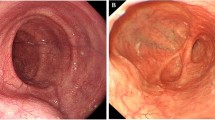Abstract
Background and study aims
At present, peroral endoscopic myotomy (POEM) has been considered as the recommended treatment for achalasia, as it causes trauma to a smaller area and has fewer short-term serious complications than other treatments. However, due to the different morphology of esophagus, not all the patients with achalasia are eligible to receive POEM surgery. And the purpose of our study was to apply Ling classification, which proser Linghu put forward in 2011, in the preoperative assessment of POEM, expecting to reduce the occurrence rate of complications during or post-POEM.
Patients and methods
The clinical data of 341 achalasia patients were collected and classified, according to the endoscopic pictures related to the middle and the lower parts of the esophagus. The correlation between Ling classification and LESP or Eckardt score was analyzed for the efficiency estimation, and the correlation of Ling classification and incidence of complications was counted for the safety evaluation.
Results
Ling classification was correlated with the LESP of 95 patients and Eckardt score of 131 patients. Compared to preoperative data, post-POEM LESP and Eckardt score both decreased significantly in all types of Ling classification (p < 0.05), while no significant difference in the decrease degree of either LESP or Eckardt score was found among different types of Ling classification (p > 0.05). This means Ling classification may not directly affect the postoperative efficacy of POEM. By analyzing the correlation between Ling classification and intraoperative complications, we found that the differences of total complications, gas-related complication and mucosal injury were all significant among all types of Ling classification (p < 0.05).
Conclusions
Ling classification can be applied in the preoperative assessment of the safety and efficacy of POEM, and it might provide a guideline for how to reduce the complications during POEM surgery.


Similar content being viewed by others
References
Boeckxstaens GE, Zaninotto G, Richter JE (2014) Achalasia[J]. Lancet 383(4):595–608
Vaezi MF, Pandolfino JE (2013) Mf. V. ACG Clinical Guideline: Diagnosis and Management of Achalasia[J]. Am J Gastroenterol 108(8):3406–3412
Friedel D, Modayil R, Iqbal S et al (2013) Per-oral endoscopic myotomy for achalasia: an American perspective[J]. World J Gastrointest Endosc 5(9):420–427
Tantau M, Crisan D (2015) Peroral endoscopic myotomy: time to change our opinion regarding the treatment of achalasia? [J]. World J Gastrointest Endosc 7(3):237–246
Yaqi Z, Enqiang LU, Li Huikai et al (2013) Comparison of peroral endoscopic myotomy with transverse entry incision versus longitudinal entry incision for achalasia. J South Med Univ 33(9):1399–1402
Yang D, Wagh MS (2013) Peroral endoscopic myotomy for the treatment of achalasia: an analysis [J]. Diagn Ther Endosc 2013:389596
Huikai L, Enqiang LU (2013) New endoscopic classification of achalasia for selection of candidates for peroral endoscopic myotomy [J]. World J Gastroenterol 19(4):556–560
Linghu E (2014) Therapeutics of digestive endoscopic tunnel technique, 1st edn. Springer, Berlin
von Renteln D, Inoue H, Minami H et al (2012) Peroral endoscopic myotomy for the treatment of achalasia: a prospective single center study. Am J Gastroenterol 107(3):411–417
Author information
Authors and Affiliations
Corresponding author
Ethics declarations
Disclosures
All authors have no conflicts of interest or financial ties to disclose.
Rights and permissions
About this article
Cite this article
Chai, N., Zhang, X., Xiong, Y. et al. Ling classification applied in the preoperative safety and effectiveness assessment of POEM. Surg Endosc 31, 368–373 (2017). https://doi.org/10.1007/s00464-016-4981-z
Received:
Accepted:
Published:
Issue Date:
DOI: https://doi.org/10.1007/s00464-016-4981-z




